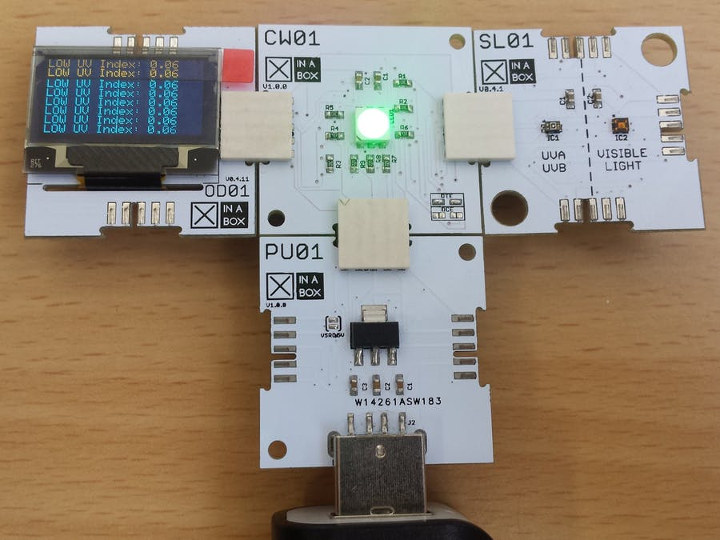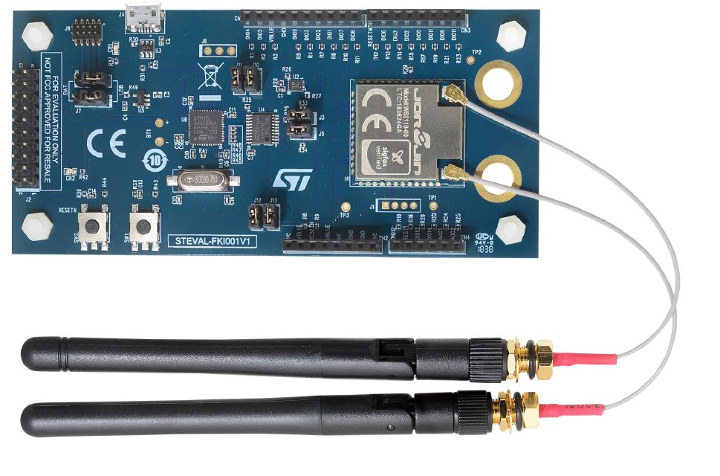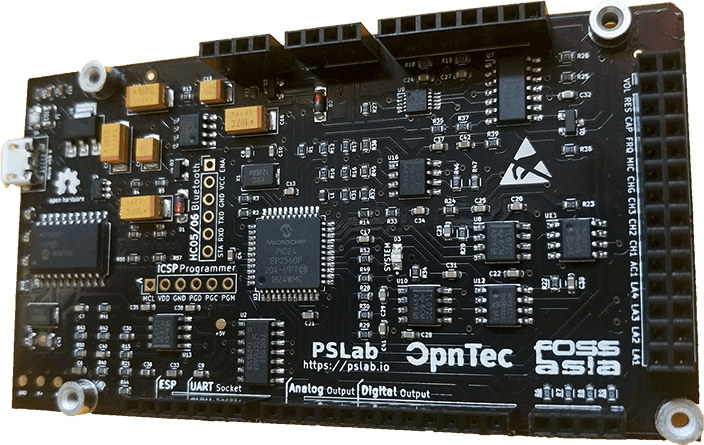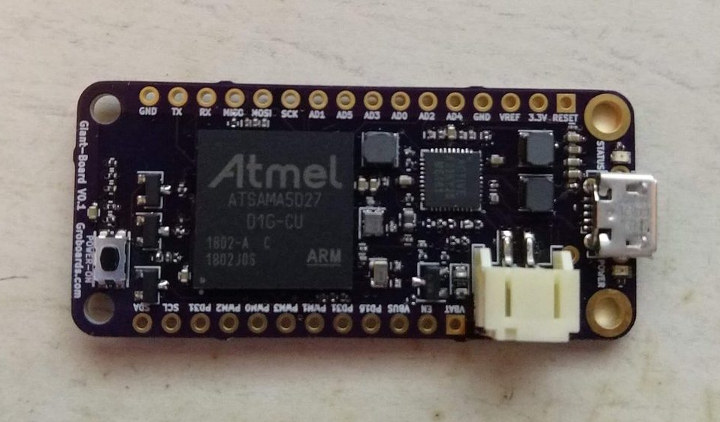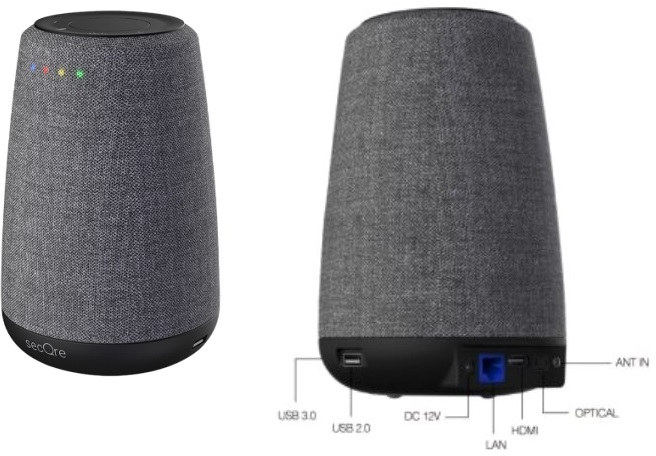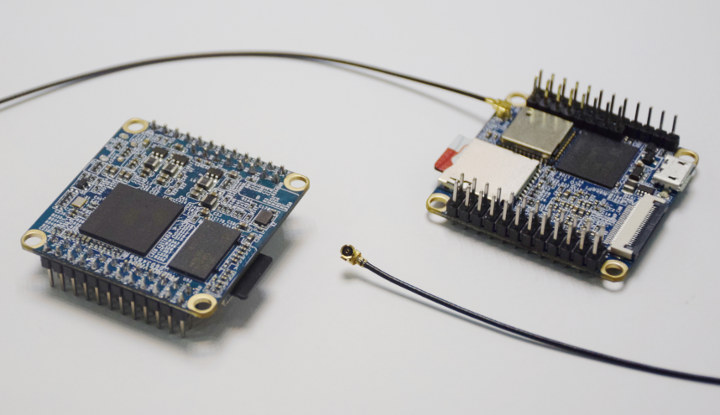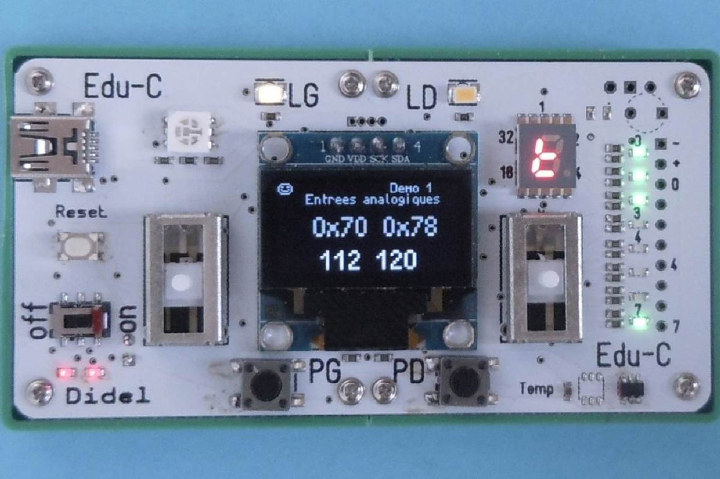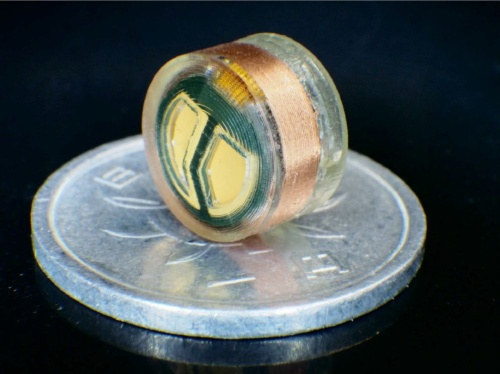So today, I decided to have a look a 96Boards website to see if there was anything new from the community, and I came accross “X in a Box B901“, an “☒CHIP is designed to interface with the 96 Boards, such as the Dragonboard 410c. This provides an interface to support the ☒CHIP ecosystem, adding support for many additional sensors etc…” I had no idea what it was all about, so obviously I had to investigate. Xinabox (X in a Box) is an ecosystem of modular electronics boards used for developing, making products and learning. There are now over 70 modular xChip” with cores/CPUs, sensors, power, communication, output, and storage. They are interconnected together without wires, soldering, breadboards, and adapters are provided for Raspberry Pi, 96Boards, and other development boards. xChips can be sorted into 8 categories: Cores – MCU/CPI cores based on Microchip ATMega328P, SAMD21, ESP8266, or ESP32 with […]
STMicro Introduces STEVAL-FKI001V1 Dual-Radio Bluetooth/LPWAN IoT Development Kit
STMicro has just launched a new development kit – STEVAL-FKI001V1 – that integrates two radios, one at 2.4 GHz for Bluetooth Low Energy (BLE), and another sub-GHz radio for LPWAN IoT standards such as Sigfox. The devkit targets the development of IoT devices such as smart sensors, finders, and trackers for smart-home or smart-building scenarios, asset-tracking, energy-management, smart-farming and industrial monitoring, and control use cases. STEVAL-FKI001V1 devkit key features & specifications: Jorjin WS2118-00 Sigfox & BLE module Embedded BlueNRG-132 Bluetooth LE Arm Cortex-M0 SoC with up to +8 dBm BLE RF output power, receiver sensitivity of -88 dBm Embedded S2-LPQTR ultra-low power sub-1 GHz transceiver tuned for 826-958 MHz frequency bands Up to +16 dBm sub-1GHz RF output power, receiver sensitivity down to -130 dBm Modulation schemes: 2-(G)FSK, 4-(G)FSK, OOK, and ASK Air data rate from 0.1 to 500 kbps Ultra-low power consumption: 7 mA RX, 10 mA TX @ +10 dBm; low duty cycle RX/TX operation mode, […]
PSLab Electronics Lab Board is Now Available for $65
Pocket Science Lab (PSLab) is an open source hardware USB board that aims to bring electronics labs to the masses, as it can act as an oscilloscope, voltmeter, programmable voltage and current source, logic analyzer, or signal generator when connected to a PC or mobile phone. This is not professional equipment, and instead designed for STEM education. When we first covered the board in August, it was still in development, but I’ve just found it is now listed and in stock on Seeed Studio for $64.90. FOSSASIA and OpnTec are the organization behind the board’s development. Here’s a reminder of PSLab board main specifications: MCU – Microchip PIC24EP256GP204 16-bit microcontroller @ up to 70 MHz with 32KB SRAM, 256KB flash Wireless Connectivity Footprint for ESP8266 module (ESP-12E) for 802.11 b/g/n WiFi (on bottom of board) Bluetooth extension slot 4-Channel, up to 2MSPS Oscilloscope 12-bit Voltmeter. Programmable gain. Input ranges from […]
Tiny Giant Board Runs Linux, Follows Adafruit Feather Form Factor
If you want a tiny single board computer that runs Linux on Arm Cortex-A processor, some options include Raspberry Pi Zero (W), PocketBeagle, or FriendlyElec NanoPi Duo with the latter being smaller and more powerful than RPi Zero although it lacks video output. Another potential option that may become available soon is the Giant Board, which as its name clearly does not imply, is a really tiny board powered by Microchip Atmel SAMA5 Cortex-A5 processor, and leveraging Adafruit Feather form factor. Giant board preliminary specifications: SiP – ATSAMA5D27C-D1G with Microchip SAMA5D2 Arm Cortex-A5 Processor 500MHz, 128MB DDR2 RAM Storage – Micro SD slot for OS and storage Peripherals & I/Os 6x 12-Bit ADC with 3.3V Reference 4x 16-Bit PWM ADC external trigger PWM external trigger 1x I2C, 1x SPI, 1x UART Misc- Power button Power Supply 5V via micro USB port 3.7V LIPO support for portable projects The Microchip / […]
SEI 520 is a 2-in-1 Android TV Hybrid Set-top Box and Smart Speaker
SEI Robotics has showcased a new device at CES 2019 that looks like a smart speaker, and SEI 520 is indeed a smart speaker with Google Assistant support, but it also adds a digital TV tuner and a quad-core Cortex A53 processor running Android TV 9.0 operating system to allow you to watch live TV, and stream videos. Preliminary specifications for SEI 520 smart speaker: SoC – Quad core Arm Cortex-A53 processor, possibly Amlogic S905X2 System Memory – 2GB RAM Storage – 16GB eMMC flash Video Output – HDMI up to 4K UHD Video Decode – VP9 and H.265/HEVC Audio Output – HDMI audio + optical S/PDIF Input – Far-field microphone Speaker – No technical details provided Connectivity – Ethernet, 2T2R MIMO WiFi, Bluetooth 5.0 Tuner – DVB-S2X/T2/C, ATSC, ISDBT USB – 1x USB 3.0 port, 1x USB 2.0 port Misc – IR blaster Power Supply – 12V DC via […]
tinyWiFi-5G is a NanoPi NEO Air Clone with 5 GHz WiFi
NanoPi NEO Air is a tiny Allwinner H3 board with 802.11 b/g/n WiFi connectivity that launched in 2016 for $17.99 and is now available as NanoPi NEO Air-LTS (Long Term Support) for $28 and up. A company – or group of software developers – called tinyDebian decided to create a clone based on NanoPi NEO Air design, but replacing the 2.4 GHz Ampak AP6212 802.11n WiFi + Bluetooth 4.0 LE module by a dual-band Realtek RTL8821CS module that supports 802.11 b/g/n/ac and Bluetooth 4.2 LE. Meet tinyWiFi-5G. NanoPi NEO Air comes with two different storage configuration (8GB or 32GB flash), but tinyDebian did not provide the full specifications of the board, so tinyWiFi-5G board specifications below are preliminary: SoC – Allwinner H3 quad-core Cortex A7 @ 1.2 GHz with an ARM Mali-400MP2 GPU System Memory – 512 MB DDR3 Storage – 8GB eMMC Flash + micro SD card slot Connectivity […]
Edu-C Arduino Compatible Board Targets Education & Game Development
Sometimes learning can be boring, and a potentially good way to get kids more engaged is to learn by playing. Edu-C Arduino compatible board is designed to teach game development to kids old and young, so they have a lasting reward once they complete programming of the board, or they may decide to customize the game further. Edu-C hardware specifications: MCU – Microchip Atmel AVR328 microcontroller Display – 28×64 pixel OLED display + 1-digita 7-segment display Game Inputs – Left and right potentiometers Misc – 8x LEDs, left & right LEDs, RGB LED, on/off power switch, reset button, buzzer USB – 1x micro USB connector for programming (CH340) and power Power Supply – 5V via USB; LiPo battery support The board ships with a 200 mAh Lipo battery, and a charger. Educational materials are also provided, but only in French right now, except for some documents which are in English. There […]
Self-powered Swallowable Thermometer Measures Internal Body Temperature
Having just written about a thermometer board for home automation, I’ll stay on the temperature measurement topic, as I’ve found another thermometer that targets the medical field instead. Body temperature measurement at my local hospital is done under the armpit, which does the job in most cases, but more accurate temperature measurement of “deep body temperature” is normally achieved through rectal temperature measurement which is not as practical and comfortable for most people. Daily measurements of deep body temperature can apparently allow physicians to better understand “biological clocks”. In practical terms, it means doctors would be able to know ovulation cycles, measure the fatigue degrees of athletes, and even prevent heat strokes and hypothermia. Seeing the impractically in the conventional method, Nakamura Lab at Tohoku University developed a “swallowable thermometer” for this purpose. The swallowable sensor measures just 9.16mm in diameter, is allegedly perfectly safe to the human body, and […]


